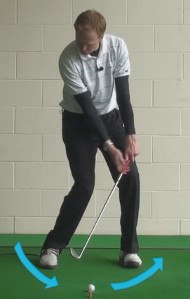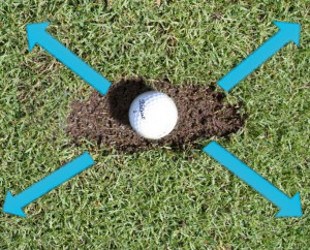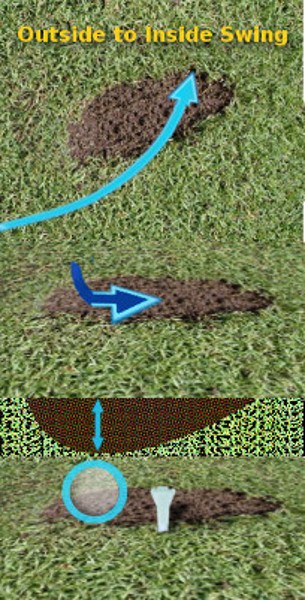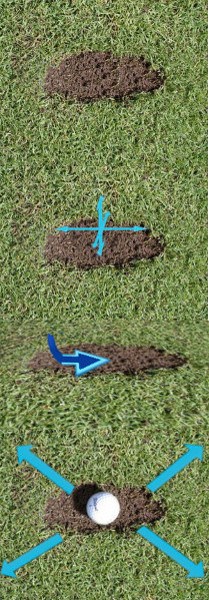
How do you know if your swing path is outside-to-inside, straight down the line, or inside-to-out? The secret is in the dirt.
Specifically, it's in your divots. A little forensics work can uncover valuable clues lying in these slivers of sliced-out turf left by your irons and, in some cases, hybrids and fairway woods. In fact, you'd be amazed how much one little ground gash can reveal: misalignment, a faulty swing path, a swing that's too steep or shallow, and clubs that are improperly fit, among other things.
When examining divots you're primarily hunting for three things: direction, depth and digging. Let's take them in order:
- Direction: If you're hitting the ball consistently right or left, stand behind your divot and hold a club vertically to line it up. Which way does it point? If it's off-target, you either lined up improperly, or your swing path is out of whack.
- Depth: If your divots are especially deep, your club will probably slow down abruptly – or even stop – after contact. Deep divots are a sign of a swing that approaches the ball on too steep of an angle, and often on an outside-to-in path. If you take very shallow divots or none at all, your swing could be too shallow and/or too far from the inside. In either case (deep or shallow), ball position could also be at fault. Too deep may mean it's too far back in your stance, causing you to hit straight down on it. The opposite applies on shallow divots.
- Digging: Are your divots deeper in the heel section than the toe; do they reveal a toe digging in more deeply than the heel? Excess heel digging means your clubs are too upright for your posture/swing, while deep toe divots are a sign of overly flat clubs. Have your pro or the local golf shop check this using a lie board.

If you're struggling with the iron game, investigate your divots on the driving range. They might tell you all you need to know.

Divots Provide Valuable Swing Info
Gathering information about your game is one of the most important things you can do as a golfer. The only way to improve your game in the long run is to learn more and more about your strengths and weaknesses on the course with each round that you play. What is it that you do well? What is it that is stopping you from reaching your goals? Becoming a better player means maintaining your strengths and improving on your weaknesses – but you can't accomplish that goal unless you know what your strengths and weaknesses are in the first place.
One way to gather information about your game is to carefully watch the pattern of your divots. With the exception of your tee shots, you should take some form of divot on every swing that you make, meaning that there are plenty of opportunities throughout a round to learn about your swing. The direction, shape, and depth of your divots will tell you a lot about what you are doing right in your swing, and what you are doing wrong. If you don't pay attention to your divots as you make your way around the course, you are missing a big opportunity to correct the flaws in your technique.
Of course, you shouldn't be making changes to your swing during the middle of a round, so you will want to gather up this information to use later. Simply keep an eye on the divot that you are taking, and notice any patterns that appear over time. Once those patterns are identified, you can use that information to create a plan for improvement that can be implemented on the practice range. Any adjustments to your technique need to be put into place on the driving range first before they are put to the test out on the golf course.
Learning to watch your divots will not only help you improve your swing, but it will also make you more observant in general as you play golf. The best golfers in the world are constantly seeking out even small bits of information that can help them lower their scores. You should approach the game in the same way. Don't take anything for granted, even during a casual round – make a mental note of things like wind direction, turf conditions, green speeds, and more in order to give your brain all of the information it needs to help you hit great shots. Golf is more complicated than most players understand, and simply walking up to the ball and swinging away is never going to lead to long term success.
All of the instruction contained below is based on a right handed golfer. If you play left handed, please reverse the directions as necessary.

Learning from Divot Direction
The first element of your divots that you should be analyzing is the direction that they map out once taken from the ground. The path of your club head through impact is crucially important in golf, and your divots provide visual feedback as to that path. Since the club moves through the hitting area far too quickly for you to observe the path as it happens, you can use the divot has a helpful and convenience resource of information.
For most golfers, the ideal divot direction is a straight line between your ball and the target. However, creating divots that are perfectly on line is rather difficult, and even a professional golfer won't accomplish this goal regularly. Instead, you should be attempting to get as close to this straight path as possible with every swing. As long as you are holding your path somewhere near to the target line, you should be able to generate quality shots more often than not.
To check on the direction of your divot, stand behind the divot after you have struck the shot and compare the hole you have created in the ground with the target you had picked out for the shot. Was your club tearing through the ground on a path that was in line with your target, or was it moving to the right or left dramatically? It should only take a quick glance to get an answer to this question. Remember, you don't want to slow up play for others on the course while you are looking at your divots, so just take a quick peek before moving on.
It is important to understand that a divot which is directed off-line doesn't necessarily mean there is something wrong with your swing. Often, a divot that is off-line will be a result of poor alignment at address rather than poor swing mechanics. If you fail to align your body correctly with the target at address, your divot will be off-line even if you make a great swing. A poorly-aligned divot only tells you that something went wrong – but that something could be within your pre-shot setup or in your swing itself. Many amateurs struggle with proper alignment on the course, so make sure you getting lined up properly before you get into making actual swing changes.
Another key point is to make sure you are ignoring the location of the actual divot once it lands back on the ground. The piece you are interested in is the hole you made in the turf – not the clump of grass and dirt that went flying out in front of you. Some golfers make the mistake of using this chunk of turf as some sort of indication of the success of the swing, but that is incorrect. The chunk of grass could fly anywhere depending on the club you are hitting and how long it stayed stuck on the face. You should always replace your divots (or fill the hole with sand, depending on course policy), but never use the landing point of the divot as a tool for swing evaluation.
While an off-line divot could indicate a number of various issues in your swing, the points below highlight the most likely problems when you see a divot pointing right or left (assuming your alignment was accurate).
- Divot pointing left. For most players, a divot pointing left of the target means an over-the-top swing has occurred. The result of this swing is usually either a pull to the left or a slice that misses well to the right of the fairway or green. If you notice a pattern of divots that are consistently pointed to the left of your target, you will need to correct your over-the-top mechanical error as soon as possible. This swing fault is often the result of a quick transition at the top of the swing, so work on your tempo to get the club back on track.
- Divot pointing right. This mistake is less common, but it can be harmful to your game just the same. When your divots are pointing right of the target on a regular basis, you can assume that you are sliding your weight toward the target in the downswing. From the top of the swing, you should be rotating (not sliding) aggressively to the left. However, some golfers start to slide their lower body right from the top, which drops the club too far inside the correct swing plane. When that happens, it is inevitable that you will hit either a push or a hook. By improving your rotation in the downswing, you should be able to eliminate the lateral slide that is causing your poor divot pattern.
Monitoring your divot direction is something simple that you can do on a regular basis. Hopefully, your divots will look great the majority of the time, and you won't have to worry about making any changes. By watching them consistently, however, you can spot problems as soon as they arise.

Learning from Divot Depth
Depth is another element of the divot equation that you would be wise to consider. The depth of your divots can tell you plenty about the path that your club was taking as it headed down into the ball. Obviously, you have to be swinging down at least to some degree in order to take a divot after contact – if you are swinging up, you will miss the ground entirely. However, some divots are deeper than others, and understanding what that means for your swing can help you improve.
If you take consistently deep divots out of the ground, you are swinging down on a steep plane. On the other hand, if you barely pull up a thin strip of grass after impact, you will know that your downswing is rather shallow. Both steep and shallow swings can create good shots, but they each have their own characteristics. You should know what kind of ball flight you are trying to create, and then work on making your divots match that objective.
For players who would like to hit high shots with plenty of spin, deep divots are the way to go. The steep angle of attack that is required to create a deep divot will add plenty of spin to the golf ball, which will enable it to climb high into the air. This technique can be difficult to execute with long irons, but it works great on short iron shots. In order to take deep divots with all of your irons, you will need plenty of club head speed to tear through the hitting area aggressively. If you lack swing speed, a shallower divot pattern is probably a better bet for your game. That shallower divot pattern will leave you with shots that fly lower and spin less, a ball flight that has pros and cons. On the plus side, it is generally easier to control your distance while keeping the ball low to the ground. However, you won't have as much spin to use when trying to stop the ball quickly on firm greens.
The first step in the process of picking out your ideal ball flight is determining where you are currently with your swing. Take a look at your divots during your next round (or your next visit to a grass driving range) and evaluate the depth for yourself. If you are currently a player who takes shallow divots and you would like to hit the ball higher, working on a steeper angle of attack is the obvious next step. However, if you already hit the ball high with your shallow divots, you won't want to get any steeper as that could lead to shots that fly too high to be controlled.
After comparing the current depth of your divots to the type of swing you would like to make, you can get down to work on making the necessary corrections. As a general rule, you will need to lower your hands at the top of the swing in order to make shallower divots, and you will need to get your hands higher to create deeper divots. The angle of your downswing is what determines the depth of your divots, and that angle starts from the very top. Get your hands in the correct position as the backswing is completed and you should be able to produce the proper divot depth for the shots you would like to hit.

Learning from Divot Shape
Among golfers who already know to observe their divot patterns in order to improve their performance, the review usually stops after looking at the direction and depth of the divots. However, there is one more important element that you should look at if you want to maximize your game – the shape of the divot. Specifically, the shape at the back of the divot, or the point where the club enters the ground. This analysis won't necessarily help you improve your golf swing, but it can help you better tailor your equipment to your game.
Ideally, you would like to see a nice square entry into the turf after your iron strikes the back of the ball. If the club is square at impact, and the club is well-suited to your swing, you will see an entry line that is perpendicular to the target line. The back of the divot will be clean and square, rather than having a point on one side or the other. If your divots are 'lopsided', you might have an equipment issue to work on correcting.
When the toe of the club goes into the ground first, you will create a divot that is longer out toward the toe than it is off the heel. The opposite is also true – if the heel digs in, the heel side of the divot will be bigger. Why does this matter? A lopsided divot can cause problems because the club face may twist open or closed as you are striking the ball if the leading edge isn't square with the ground. Playing with irons that are a good fit for your golf swing is the only way to be sure that you are getting the most from your swing, and hitting the ground with the toe or the heel first is a sure sign that something is wrong.
The following two points will help you correct the underlying problem –
- Toe going in first. On toe-heavy divots, there is a good chance that you are swinging clubs which are too flat for your swing. By having your clubs adjusted into a more upright position (by a professional club fitter), you should be able to square up your divots in no time. In fact, there shouldn't be any adjustment required to your swing at all – in this case, the correction made to the club can do all of the work.
- Heel in first. As you might imagine, the heel digging in first is a sign that your clubs are too upright. This frequently happens to shorter players, as 'standard' lie clubs will play too upright for golfers of shorter than average height. When you notice a pattern of heel-heavy divots coming off of your irons, look to have them adjusted flatter in order to better suit your swing.
Uneven divots is a problem that should be addressed right away, because it isn't going to go away without intervention. If you allow this problem to linger, you might start to subconsciously adjust your swing technique in order to cater to your miss-fit clubs – which would be a bad idea. Get your equipment right by having the length and lie adjusted to your needs so you can strike the ground cleanly time after time.

A Point on Golf Psychology
Divots can provide you with valuable information about your golf swing – on that point, there is no debate. However, watching your divots can come with a downside. Along with the information you gain that can help you improve in the long run, you also may suffer from a crisis of confidence as you see that there is something wrong with your technique. You won't be able to make swing changes during a round, so you may be noticing problems in your divots while you are trying to go about the process of playing a good round of golf. In order to play your best, you want your mind filled with great thoughts and plenty of confidence, but that confidence could be quick to disappear as you find issues with your divot patterns.
So how do you protect your confidence while also giving yourself the chance to improve? The key is picking your spots. You don't want to track the pattern of your divots during every round that you play, because your confidence could take a serious hit. Instead, only use this method of improvement during certain, specific rounds. If you are playing in a tournament at your local club, ignore your divots and simply work on shooting the best score possible. If you are playing a casual round by yourself, however, you may want to use your divots in an effort to improve. You won't feel much pressure when out playing by yourself, so even if your confidence dips, you should still be able to enjoy the day while working on your game.
When thinking about how (and when) to improve your golf game, take a look at your calendar for the year. You want to schedule swing improvements for a time during the year when you won't be playing in many competitions. Along those lines, you should only take a close look at your divots during a 'down' time of the year when you can afford to work on your game. Consider planning two or three practice rounds with the specific purpose of watching your divots carefully throughout the day. This would be a great way to kick off a period of game improvement - play a couple of rounds while monitoring your divots, and then complete several practice sessions over the next few weeks where you work on the issues that were discovered through your divots.
The confidence that you have in your golf swing is just as important as the swing itself. If you don't trust yourself to hit great shots in key situations, it doesn't matter how pretty your swing looks on the range – you will never get it done on the course. Confidence is absolutely essential to playing good golf, so don't risk your confidence by overanalyzing your divots during key rounds. Divots can be a valuable tool, but only when used at the right time.
A smart golfer won't overlook any opportunity to improve, even with something as seemingly trivial as the shape and direction of a divot. In reality, your divots can tell you a lot about your golf swing, so they are certainly worth watching carefully. As long as you don't put too much emphasis on watching your divots during important rounds, this method can be a useful tool in your pursuit of a better golf swing. There is no such thing as 'good enough' in golf. Every player can improve, and watching the pattern of your divots is one way to do just that.






